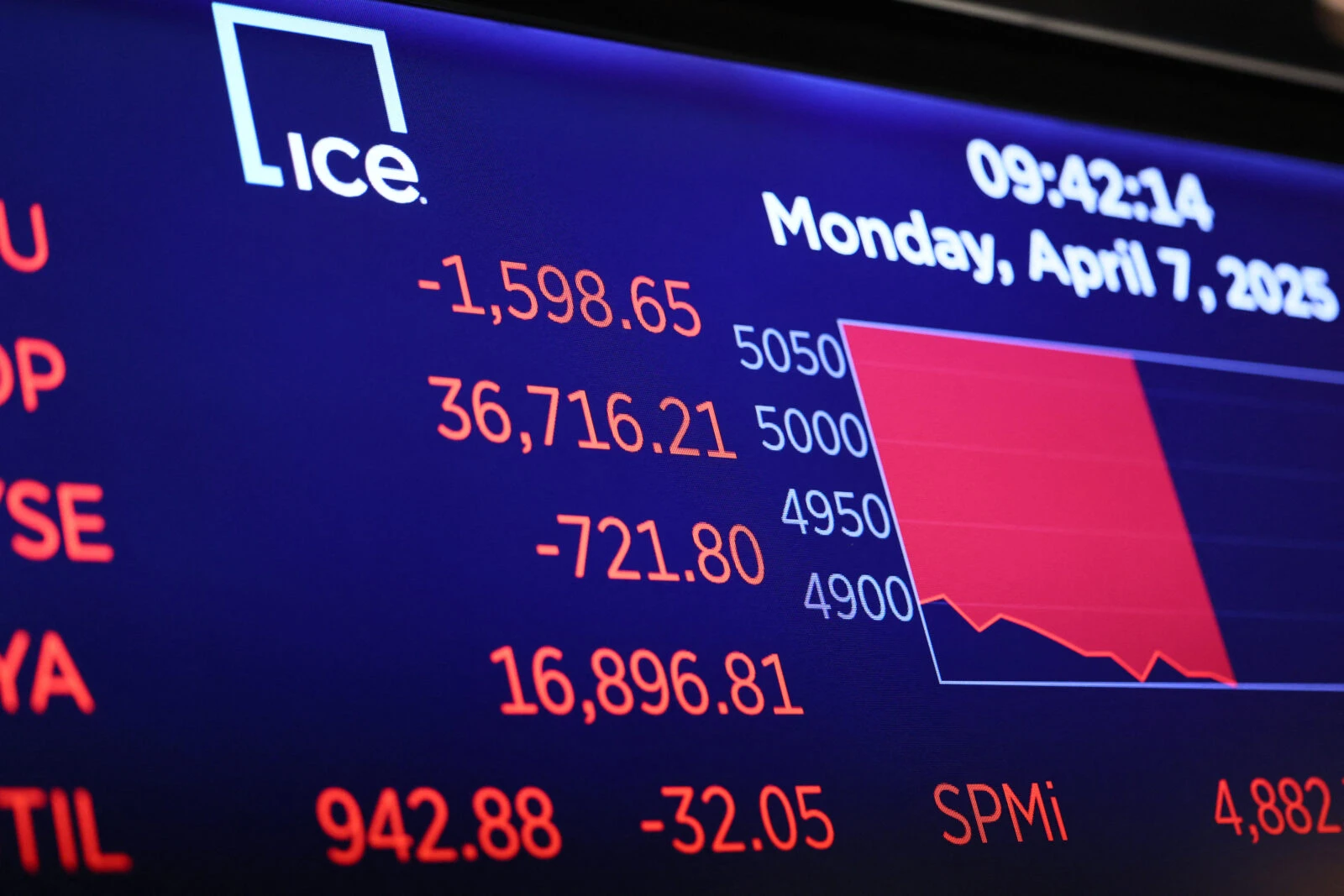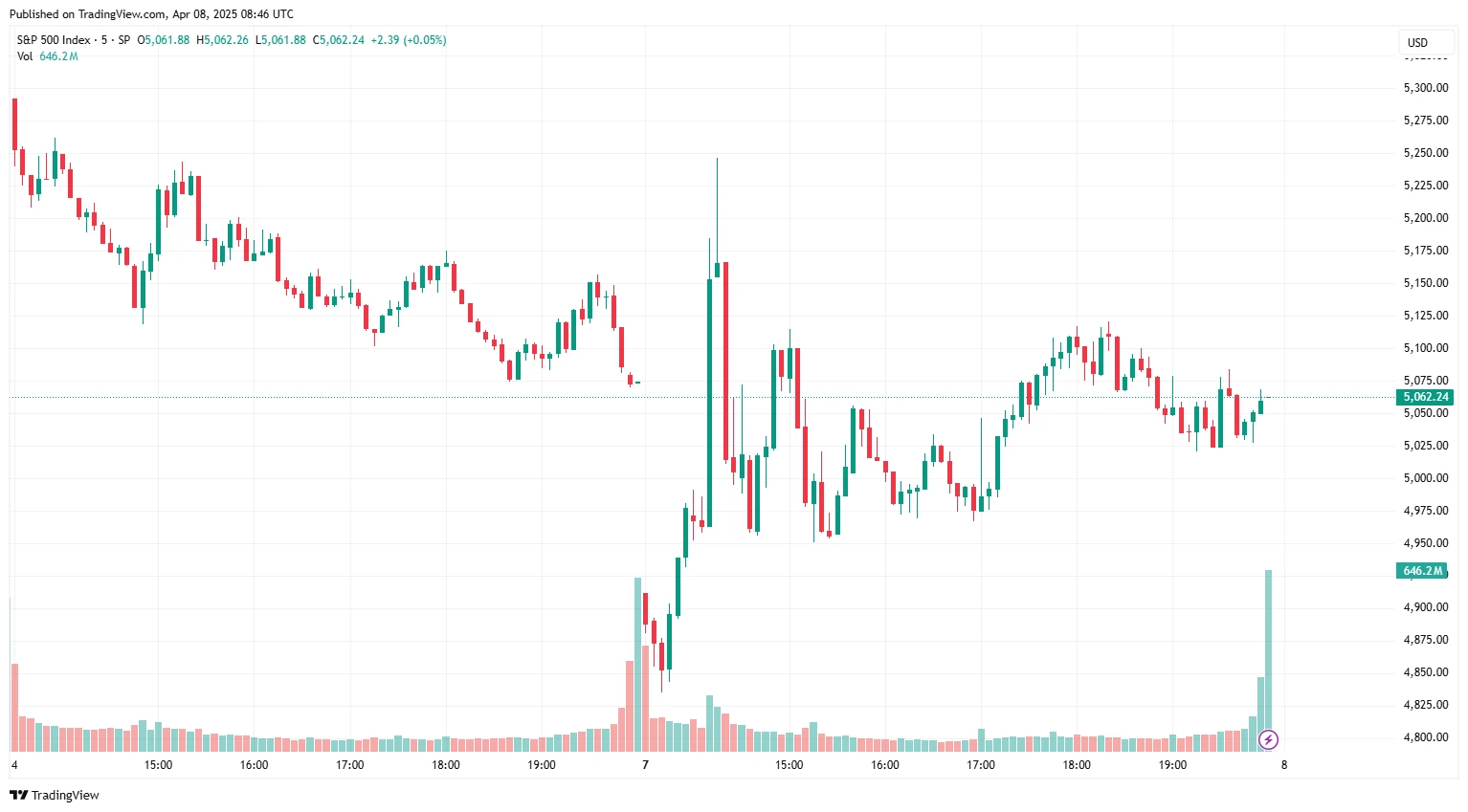Wall Street in mayhem: $2.4T rally wiped out in minutes
 A picture of US President Donald Trump sits on a deak on the floor of the New York Stock Exchange (NYSE) at the opening bell in New York City, on April 7, 2025. (AFP Photo)
A picture of US President Donald Trump sits on a deak on the floor of the New York Stock Exchange (NYSE) at the opening bell in New York City, on April 7, 2025. (AFP Photo)
The New York Stock Exchange (NYSE) ended Monday with mixed results after one of the most volatile trading sessions in recent memory—sparked by intensifying trade war tensions and fueled by an unverified news report that temporarily reversed a deep sell-off.
The day opened in Wall Street with a wave of panic selling that rippled across global markets, triggered by a massive downturn that began in Japan and spread to all major indexes. The sell-off was driven by growing fears of an escalating trade war between the United States and China. Investors rushed to offload shares amid mounting uncertainty over global economic stability, prompting some analysts to compare the speed and scale of the decline to the infamous “Black Monday” crash of 1987.
However, the sharp decline abruptly reversed when a social media post—later echoed by major news outlets including Reuters and CNBC—claimed that President Donald Trump was considering a 90-day suspension of tariffs on all countries except China. Although the report lacked official confirmation, the mere suggestion of a possible de-escalation was enough to spark a buying frenzy across Wall Street.
Initial sell-off followed by whiplash rally
At the opening bell, the Dow Jones Industrial Average—an index of 30 major U.S. companies—plunged 1,145.63 points, or nearly 3%, reaching 37,169.23 as of 10:00 a.m. EDT. The broader S&P 500 fell 107.51 points, or 2.13%, to 4,958.76, entering bear market territory, a term used when an index falls more than 20% from a recent high. The Nasdaq Composite, which is heavily weighted with technology stocks, dropped 291.39 points, or 2.04%, to 15,323.27.

Shortly afterward, markets rebounded sharply in response to the viral rumor suggesting a possible tariff pause. The source cited National Economic Council Director Kevin Hassett as saying Trump was considering a 90-day tariff halt, though only excluding China. This unverified statement quickly gained traction on X, and its amplification by reputable news platforms added to the credibility in the eyes of investors.
As a result, the S&P 500 saw a stunning recovery. From a 4.7% drop earlier in the session, the index surged by 3.4%—a swing of over 8 percentage points. Between 10:08 a.m. and 10:18 a.m., the S&P 500 added a staggering $2.4 trillion in market value, underscoring just how sensitive the markets are to any indication of progress—or confusion—on the trade front.
White House denial sends markets back down
However, the gains were short-lived. The White House officially denied the reports, stating that there were no plans to suspend tariffs. Markets reacted instantly. Within 23 minutes, the S&P 500 lost $2.5 trillion in value—erasing all earlier gains and reflecting how fragile investor sentiment has become in the current climate.
By the end of the day, the Dow Jones closed down 0.91%, or 349.26 points, at 37,965.6. The S&P 500 slipped 0.23%, or 11.83 points, to 5,062.25—its lowest closing level in nearly a year. Only the tech-heavy Nasdaq Composite managed to post a marginal gain, inching up 0.1%, or 15.48 points, to 15,603.26.

The CBOE Volatility Index (VIX)—commonly referred to as the “fear index” because it measures market expectations for near-term volatility—rose 3.69% to 46.98, indicating heightened investor anxiety.
“Magnificent Seven” continue their slide
The group of high-performing tech giants known as the “Magnificent Seven” extended their recent losses amid heightened market volatility. Tesla led the decline, falling over 7% to $223 per share. Nvidia and Apple each dropped more than 5%, while Meta, Microsoft, and Alphabet lost over 3%. Amazon also slid more than 2%. Apple, Alphabet, and Microsoft all traded near one-year lows.
According to Reuters, the group has collectively lost over $6 trillion in market capitalization since peaking in late 2024, with the decline accelerating after President Trump’s tariff announcement last week.

Apple alone has shed 13%—equivalent to approximately $368 billion in market value—over the past five trading sessions.
Analysts note that the “Magnificent Seven” stocks have been responsible for a significant share of the $5 trillion in total losses the S&P 500 has suffered over the last two sessions.
Trade war rhetoric heats up
Amid the market chaos, trade war rhetoric between Washington and Beijing intensified.
White House National Economic Council Director Kevin Hassett said on Sunday that more than 50 countries affected by the U.S. tariffs—set at a minimum of 10%—have reached out to Washington seeking negotiations.
President Trump, while confirming openness to talks, denied reports that he was considering a pause in tariffs. “We’re not looking at that,” Trump said during a press conference with Israeli Prime Minister Benjamin Netanyahu at the White House.
Last Wednesday (April 2), Trump announced a 10% baseline tariff on all imports, with even higher reciprocal tariffs targeting major trading partners, including China and the European Union.
The U.S. administration revealed that China would face an additional 24% retaliatory tariff on top of the 10% baseline—totaling a 34% duty. In response, China announced that it would impose the same level of tariffs on U.S. goods.
Trump further warned that if China does not roll back the retaliatory 34% tariff by April 8, the U.S. will impose an additional 50% duty and cancel planned trade negotiations.
China’s Ministry of Commerce responded Tuesday, stating that it would take “firm countermeasures” if the U.S. proceeds with the 50% tariff threat.



